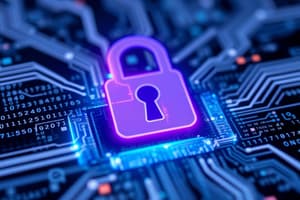Podcast
Questions and Answers
What is the primary purpose of authenticating electronic documents?
What is the primary purpose of authenticating electronic documents?
- To establish the identity of the sender (correct)
- To ensure the confidentiality of the data
- To verify the integrity of the data
- To ensure timely delivery of the data
What is validated during the authentication process?
What is validated during the authentication process?
- The identity of a user, device, or entity (correct)
- The integrity of the data
- The security of the system
- The confidentiality of the data
What is the term for verifying the claimed identity of a user or entity?
What is the term for verifying the claimed identity of a user or entity?
- Verification
- Authorization
- Validation
- Authentication (correct)
What is the result of successful authentication?
What is the result of successful authentication?
What is the context in which authentication is used?
What is the context in which authentication is used?
What is the key element in authenticating an electronic signature?
What is the key element in authenticating an electronic signature?
What is required to authenticate an electronic data message or electronic document?
What is required to authenticate an electronic data message or electronic document?
What is the purpose of authenticating an electronic signature?
What is the purpose of authenticating an electronic signature?
What is involved in the authentication process of an electronic signature?
What is involved in the authentication process of an electronic signature?
What is the result of authenticating an electronic signature?
What is the result of authenticating an electronic signature?
Flashcards are hidden until you start studying
Study Notes
Electronic Authentication
- Electronic documents, electronic data messages, and electronic signatures require authentication.
- Authentication involves demonstrating, substantiating, and validating a claimed identity.
- The claimed identity can belong to a user, device, or another entity.
- The authentication process takes place within an information or communication system.
Electronic Signature Authentication
- An electronic signature is authenticated by proof that a person employed or adopted a specific symbol, such as a letter, character, number, or other symbol.
- The person must have executed or adopted the symbol with the intention of authenticating or approving an electronic data message or electronic document.
- The authentication of the electronic signature is based on the person's intention to validate or approve the digital content.
Studying That Suits You
Use AI to generate personalized quizzes and flashcards to suit your learning preferences.




